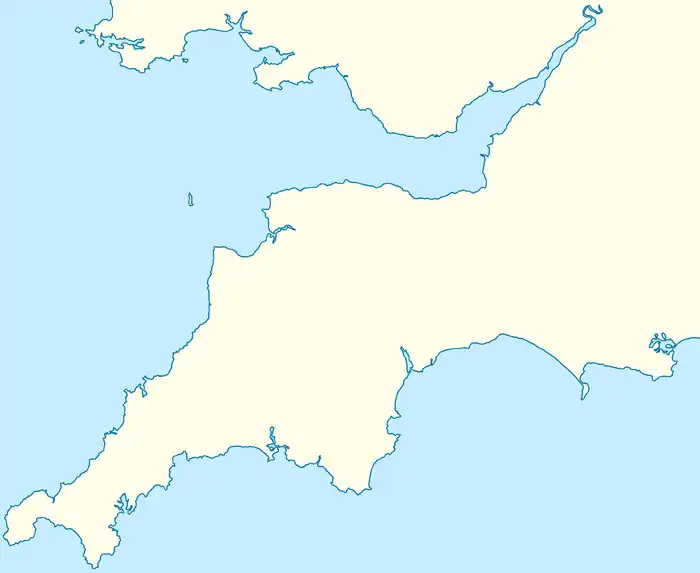Battle of Stratton
The Battle of Stratton, also known as the Battle of Stamford Hill,[4] took place on 16 May 1643, during the First English Civil War. In the battle, the Royalists destroyed Parliament's field army in Devon and Cornwall.
| Battle of Stratton | |||||||
|---|---|---|---|---|---|---|---|
| Part of the First English Civil War | |||||||
 Site of the Battle of Stratton, c. 2010 | |||||||
| |||||||
| Belligerents | |||||||
|
|
| ||||||
| Commanders and leaders | |||||||
|
Sir Ralph Hopton Sir Bevil Grenville Sir Nicholas Slanning |
Earl of Stamford James Chudleigh | ||||||
| Strength | |||||||
|
2,400 foot[1] 500 horse 8 guns |
5,400 foot[2] 200 horse 13 guns | ||||||
| Casualties and losses | |||||||
| 90 dead[1] |
300 dead[3] 1,700 captured | ||||||

Background
When the war started, Cornwall was generally supportive of the Royalist cause, while Devon and Somerset were sympathetic to Parliament, though significant opposition existed in both areas.[5] In July 1642, King Charles named the Marquess of Hertford his Lieutenant General in the West, with Sir Ralph Hopton as his deputy. The Earl of Stamford was given command of Parliament's army in the West Country in January 1643, and appointed James Chudleigh his deputy.[6]
At Sourton Down in April, Chudleigh captured letters ordering Hopton to join forces with the Marquis of Hertford and Prince Maurice in Somerset. Hoping to destroy Hopton's army before the Royalists forces could combine, Stamford raised the largest army that he could by stripping Parliamentary garrisons throughout Devon and bringing in reinforcements from Somerset.[7]
After Stamford had his army assembled and began to move into Cornwall, he sent most of his cavalry on a diversionary raid commanded by Sir George Chudleigh to attack the Royalist garrison at Bodmin and prevent Hopton from drawing on the Bodmin garrison to reinforce his army. The ploy seemed to work as ultimately Hopton was only able to assemble a Royalist force of 2,400 foot and 500 horse to counter Stamford's invasion force of 5,600. On 15 May, Stamford and the Parliamentarian army reached Stratton. Stamford deployed his infantry facing southwest along the top of a rectangular hill that ran from the northwest to the southeast.[1][2][8]
Battle
At 5:00 am on 16 May, Hopton attacked the hill by means of four widely spaced simultaneous assaults on the face of the hill. Each of the assault columns was composed of 600 foot and 2 guns. Hopton led the first column from the southeast, while Francis Bassett led a second column and attacked from the northwest. The final two columns led by Sir Bevil Grenville and Sir Nicholas Slanning operated as separate units and attacked from the southwest. In this manner, the Royalist columns focused the strength of their attacks at four particular places along a long and dispersed Parliamentary line. In reserve behind the four Royalist columns was their cavalry.[1][2]
Close action fighting followed for the next eight hours, with determined efforts on both sides. With the Royalist troops running short of ammunition, the Parliamentarian pikemen under Major-General James Chudleigh charged Grenville's regiment. Grenville was knocked over and his troops shaken, but Sir John Berkeley's musketeers made a counter-attack that stopped the Parliamentarian momentum and began to push them back up the hill.[2]
Against the odds, the Royalist troops pushed forward reaching the top of the hill before 4:00 pm. At that point the Parliamentarians gave way and Stamford's army fled the field. Three hundred Parliamentarian dead remained on the field, together with seventeen hundred prisoners. Royalist losses were estimated to be 90 men.[1][2]
Aftermath
James Chudleigh was taken prisoner and promptly defected to the Royalists. The Earl of Stamford retreated to Barnstaple and then to Exeter, blaming the defeat on Chudleigh. George Chudleigh abandoned the Bodmin campaign and returned to Exeter. In the end, Hopton had secured Cornwall for the King and would take control of most of Devonshire within a matter of days.[9]
Citations
- MacKenzie 2020.
- Plant 19 October 2014.
- Barratt 2005.
- Battle of Stratton 2020.
- Barratt 2005, p. 6.
- Hopper 2020.
- Barratt 2005, pp. 32–38.
- The Battle of Stratton.
- Gardiner 1886, p. 162..
References
- Barratt, John (2005). The Civil War in the South-West. Barnsley: Pen & Sword Military. ISBN 1-84415-146-8.
- "Battle of Stratton". Imperial War Museums. 2020. Retrieved 29 July 2019.
- "The Battle of Stratton". UK Battlefields Resource Centre. Retrieved 27 March 2020.
- Gardiner, Samuel Rawson (1886). History of the Great Civil War, 1642-1644. London: Longmans, Green & Co.
- Hopper, Andrew J. (2020). Oxford Dictionary of National Biography. Oxford: Oxford University Press.
- MacKenzie, John (2020). "Battle of Stratton". BritishBattles.com. Retrieved 2 August 2020.
- Plant, David (19 October 2014). "Stratton, Cornwall, 16 May 1643". BCW Project. David Plant. Retrieved 2 August 2020.
Further reading
- Guest, Ken & Denise, British Battles (1997) ISBN 978-0-00-470968-0